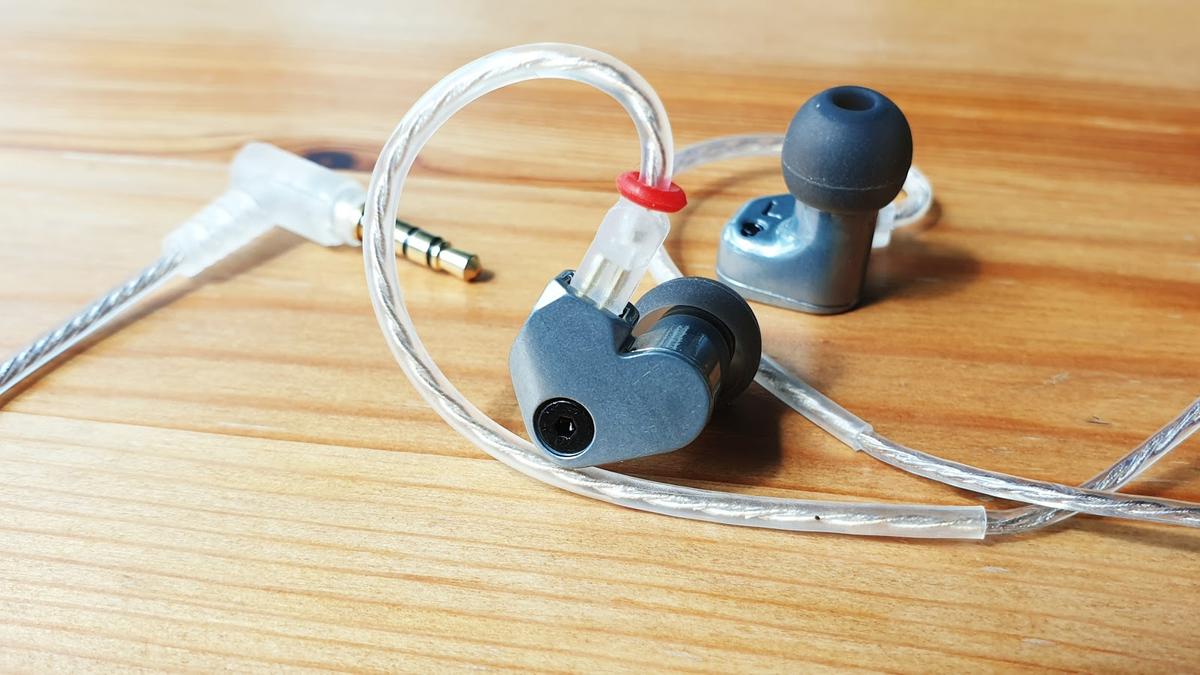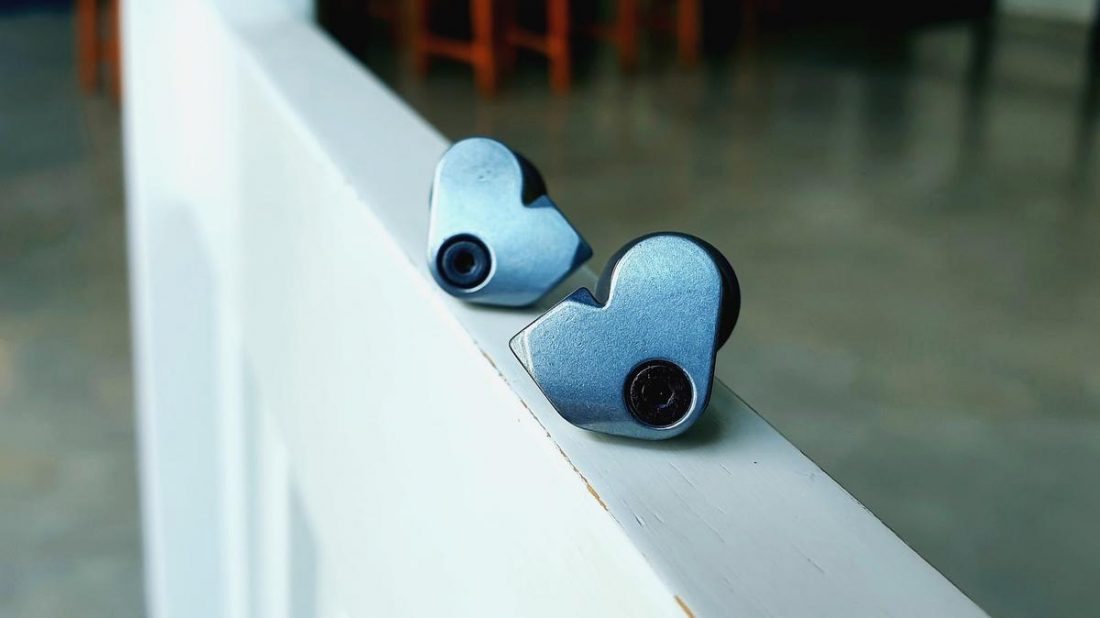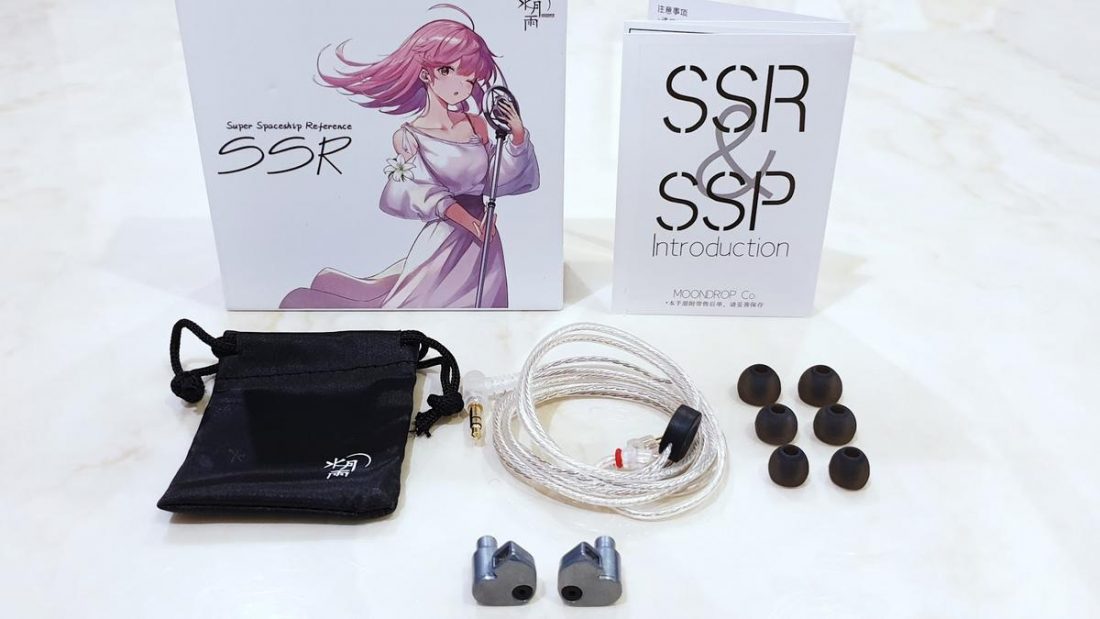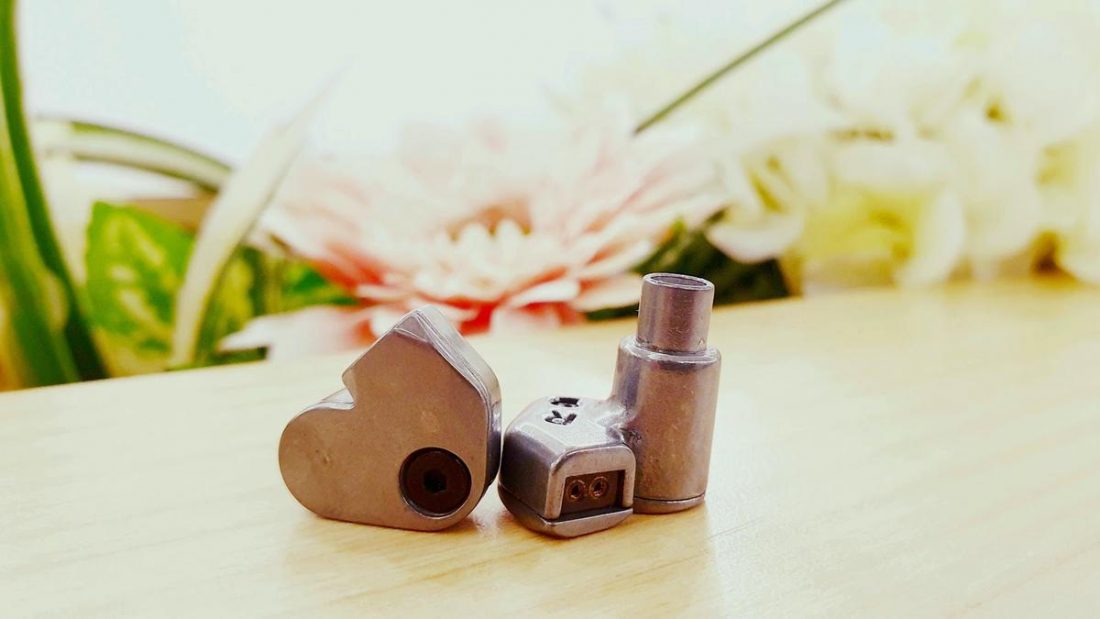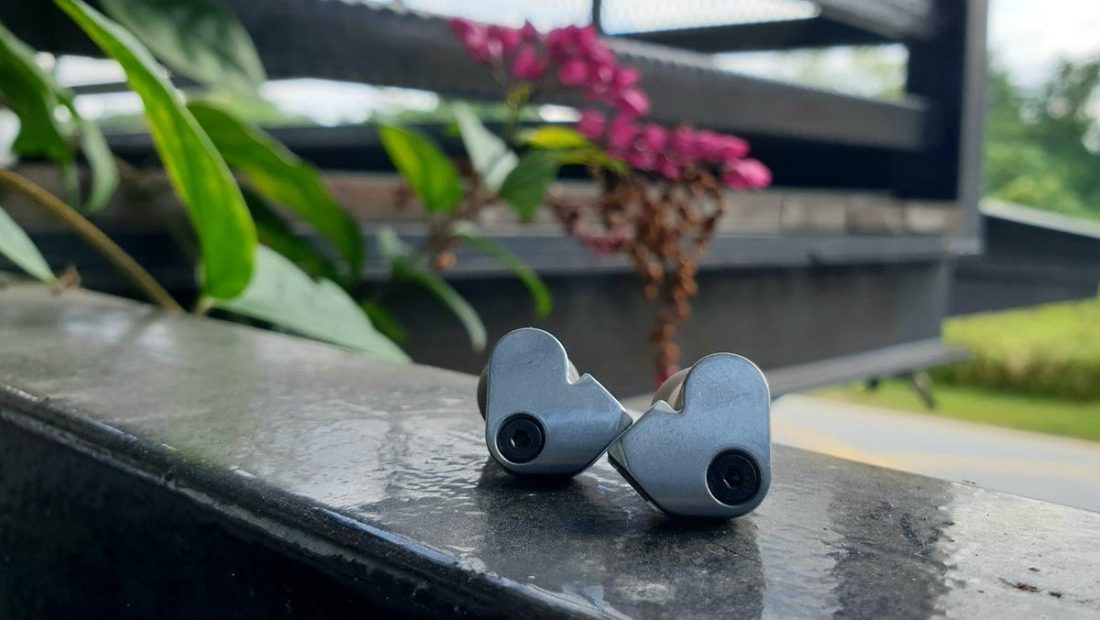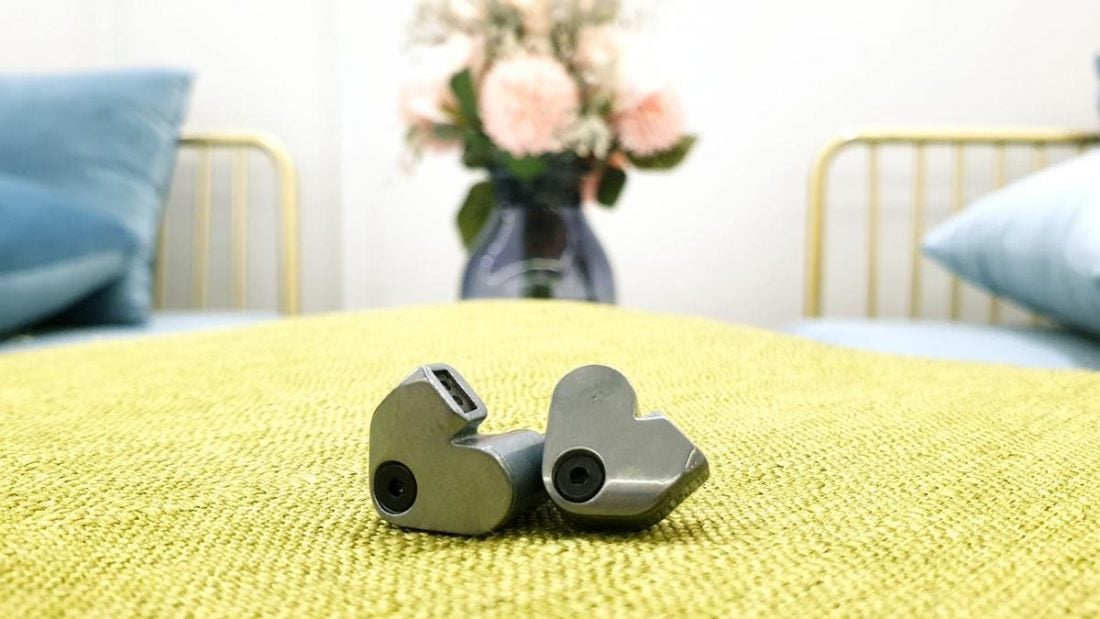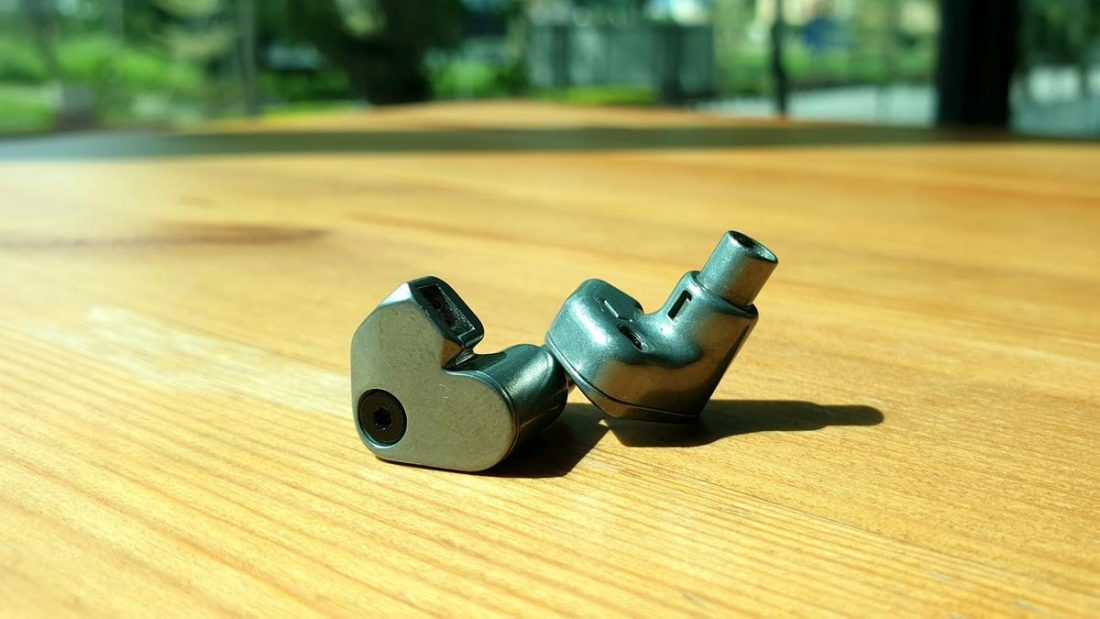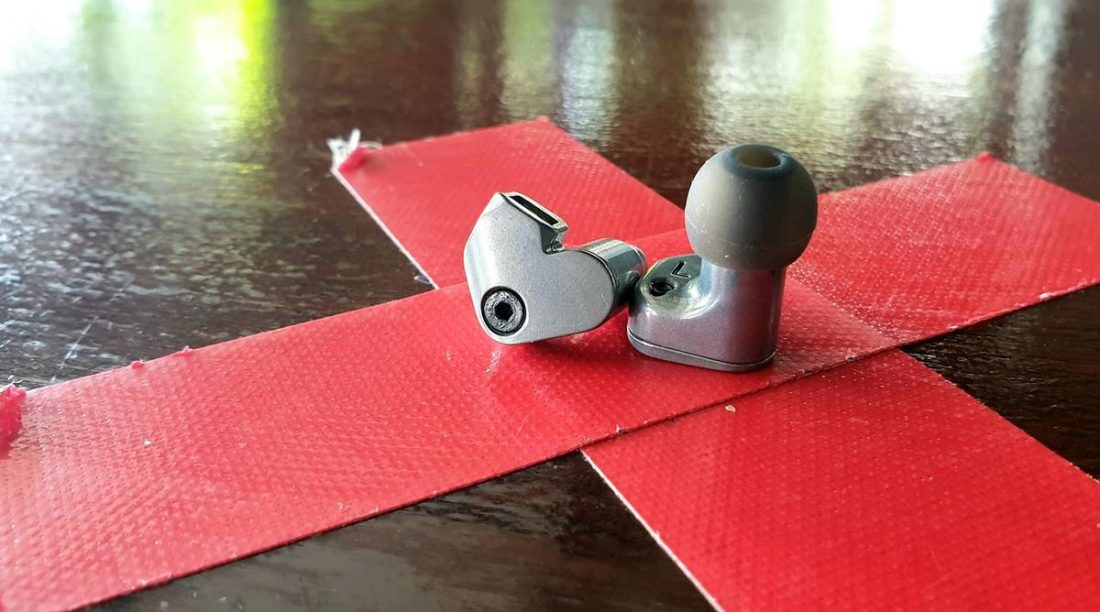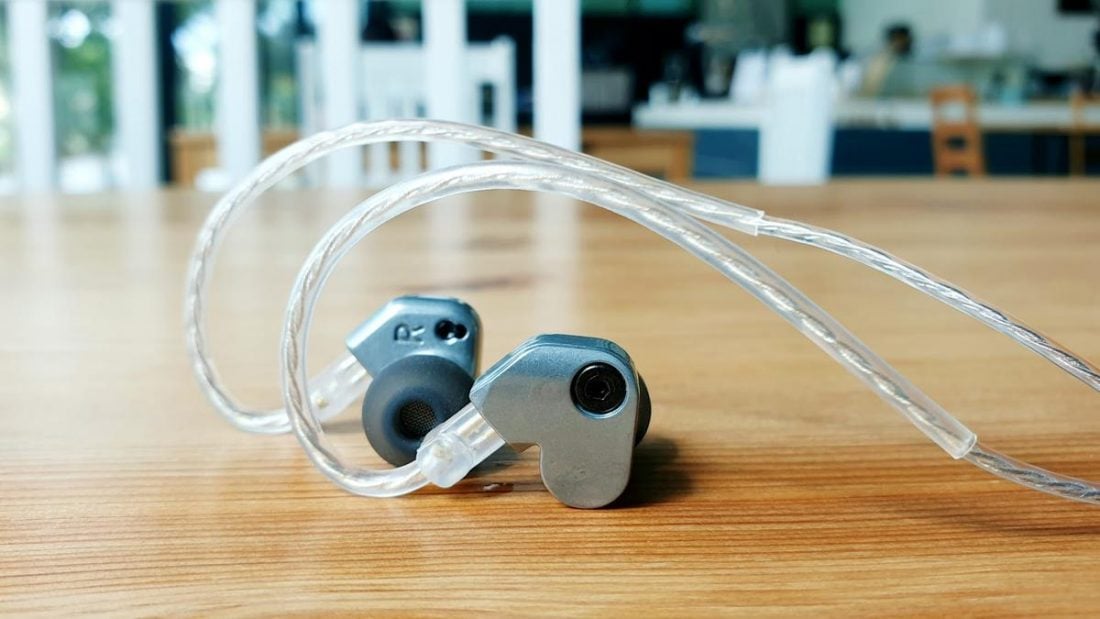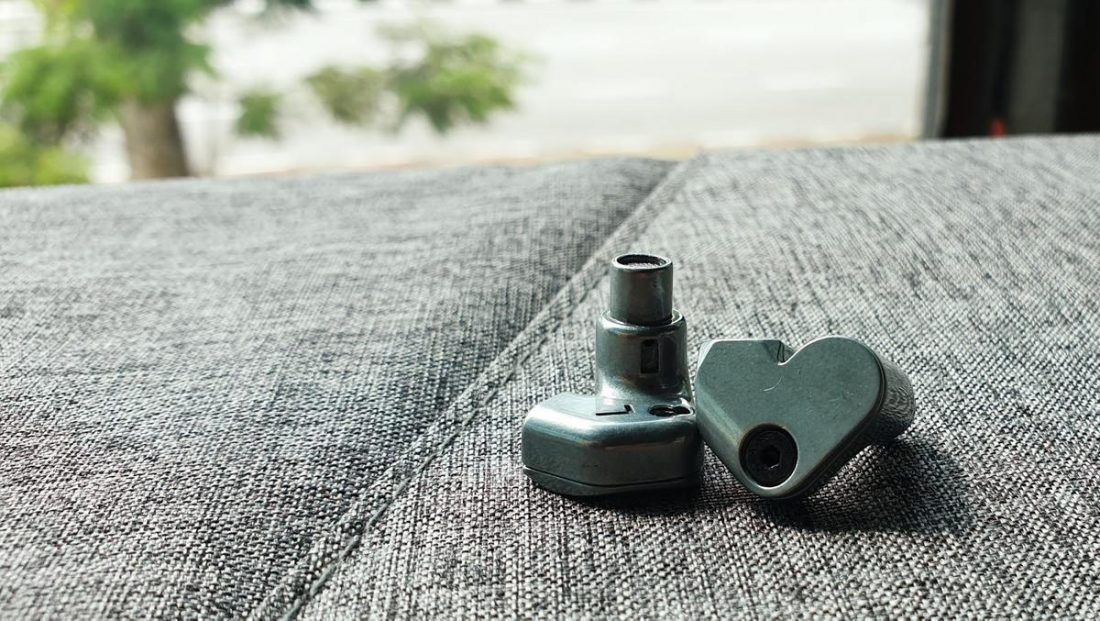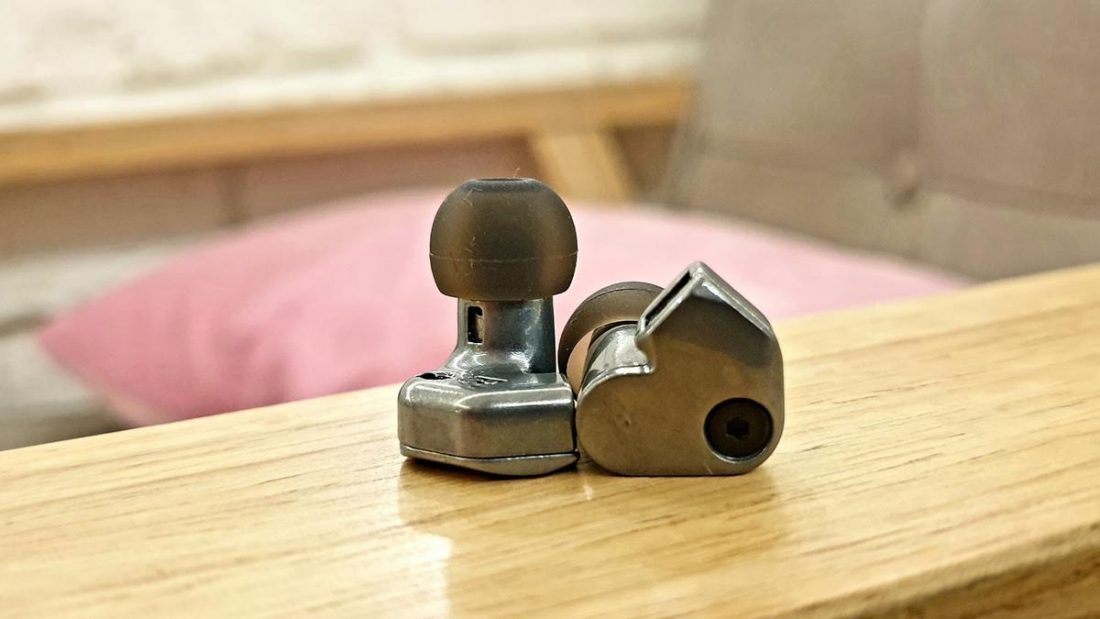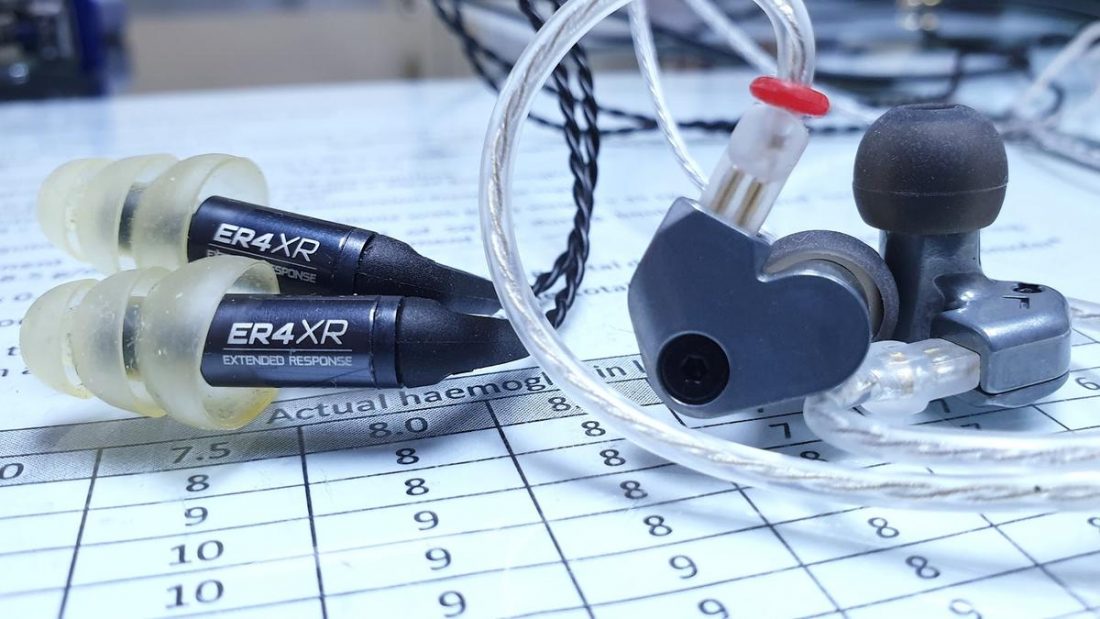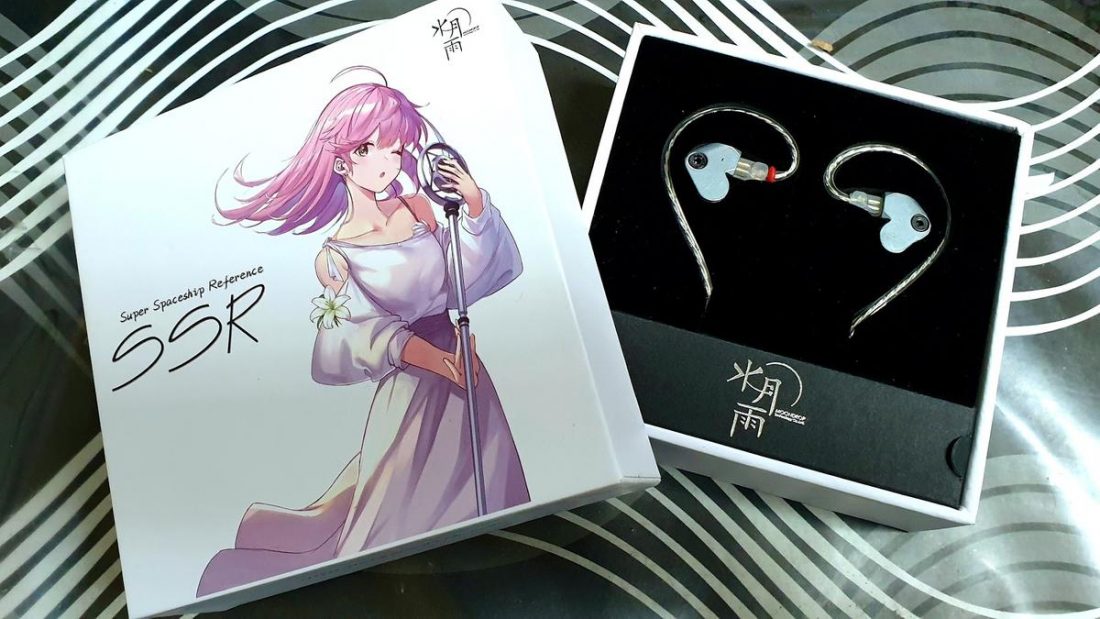General Information
Design, Build and Comfort
The SSR design takes a fresh direction from the original Spaceship elliptical shape. The design, an almost “heart” shaped from the faceplate perspective, the right-angled straight nozzle and the cable pin connector placement, at first sight, created much puzzling questions on fit and comfort. And when you pick the SSR up for the first time, it all made sense. The solution, the size. The SSR is one of the smaller sized iem you can find on the market. The small size made wearing the SSR natural and fit excellently. Just a slide in, twist forward and with the right tips, they sit snuggly in the ear.
The SSR housing uses Liquid Metal Alloy material. It has a gloss-like gunmetal textured finishing and is very lightweight and feels incredibly solid. There’s confidence in handling them without worrying if it will break or warp under rough use. The faceplate and shell are held together with a black rivet, to complete the industrial design look and feel. A small air vent is located along the inner side of the length of the nozzle. An interesting placement for the vent. The nozzle ends with a tightly knitted mesh (patented triple layer anti-clogging acoustic filter) to keep ear wax and dust out. The other end of the “heart” shaped design sits the 2-pin connector (which accepts 0.78mm 2-pin cables) and the L and R indicators clearly embedded in the housing, making cable rolling a breeze.
The stock cable comes in an interesting clear pvc jacket that houses the Silver-Plated 4N Litz cable. Something refreshing from the now common bare braided stock cable. The cable itself is more than fairly soft with a little “springy” feel to prevent tangling up. Also the 2-pin ends are fitted with a flexible memory rubber guard that retains the ear hook shape, yet easy to stretch and bend when wearing them over the ears. The right ear cable comes with a red-ring to indicator. Small details but very comfortable thought out solutions on Moondrop’s part. We can swap out the stock cable for other cables to satisfy our cable rolling needs and also add those new Bluetooth add-ons and turn the SSR into a TWS iem as well.
The heart of the SSR iem, rest the Beryllium-plated Dome with a PU Suspension Ring diaphragm, accompanied by a N52 High Density Magnetic circuit (among the highest grade of magnets available in the market) to form the engine.
Fit wise, the SSR design works excellently with my ears and the M-size tips provide very good isolation without feeling ear ache or fatigue over long listening sessions (of about 2 hours straight).


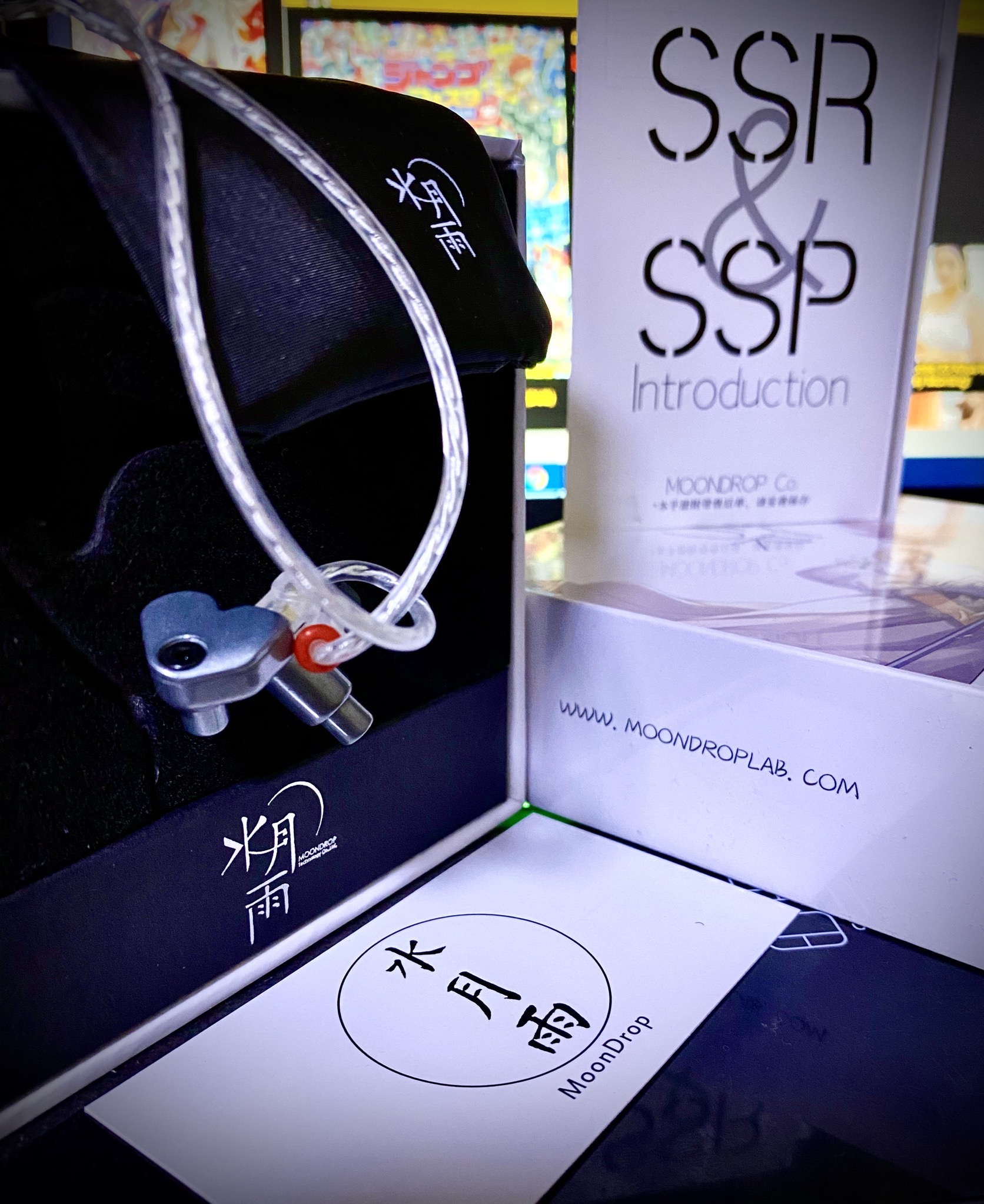
Sound Quality
For this section, the SSR iem with stock cable, were put through over 120 hours of continuous playback and followed with 24 hours of “resting” the drivers, since they arrived. This ensures during the review period, the iem sound characteristics have reached adequate maturity.
Choice of portable set-up employed in this review.
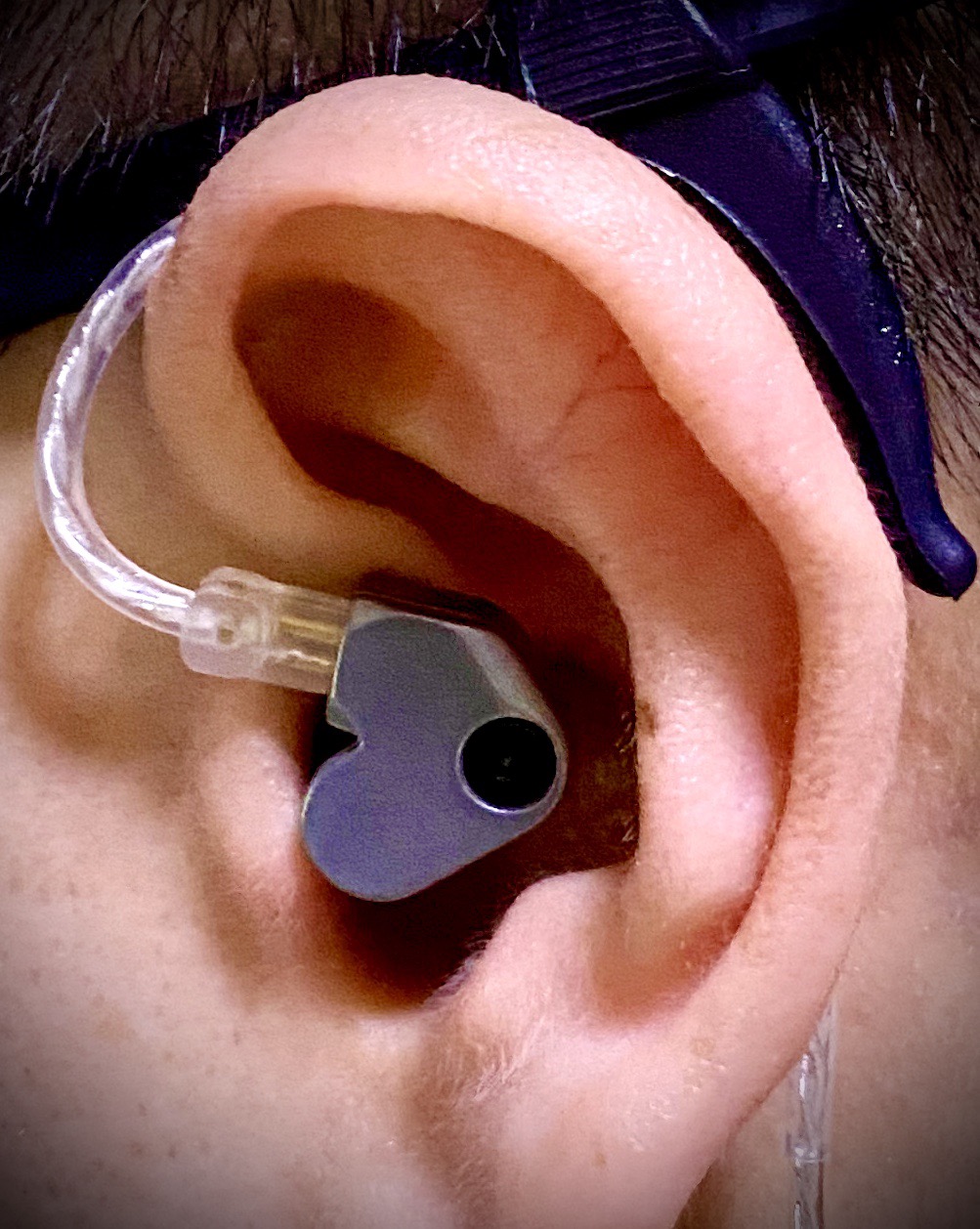
Starting things off, my immediate impression.
The SSR Super Spaceship Reference iem, given its performance, is perhaps incredibly surprising that it sits in its price bracket (USD39.99). Surprising. When we read that an iem “punches way above its price”, it has never carried more precedence than the SSR.
Moondrop’s SSR is another step in raising their game in terms of performance to price. Pushing the value chain upwards in terms of performance while keeping the price attractive.
As soon as the SSR sit in my ears and the music starts, I was greeted by the familiar Moondrop signature sound. Which connected me back to the time I first heard Moondrop’s StarField. Am not sure if it’s a coincidence or is it Moondrop’s way of connecting its range of iems in a familiar way. After some thoughts, I would say it is a positive feel good move. And that is as far as the similarities go between the StarField and the SSR.
Detail Retrieval
The SSR has a taste of picking details to be spotlighted. This nature is more evident when the SSR itself tends to have a very dark background itself. It came to my attention when playing Fleetwood Mac’s Sara and Not That Funny tracks from the Live album. The way the selected details were highlighted like the organ keys that were struck, mainly the higher keys were more pronounced and that presented the track to be heard differently from how it is usually done. Lindsey’s vocals especially the screams sounded very natural and the nuances in his scream could also be heard. Even Yanni’s Santorini track had more pronounced emphasis in some of the upper register side of the music. Be in for an adventure to hear your music a little differently.
Score : 7.5/10
Dynamics
The immediate sonic delivery is pure energy. The SSR is energetic. There is amazing energy and speed in delivering a reference-like and uncoloured sound.
The highs are vividly sparkling and shimmers before fading at the end without effort. High hats with Chimes ripple and fades almost like as quickly as it came. In most experiences, such energetic treble delivery comes with some visceral impact, and with the speed that SSR does, tend to be fatiguing in short listening sessions. Not so here. In Bee Gee’s Night on Broadway, Yanni’s Point of Origin and Ayumi Hamasaki’s We Wish tracks, it gives very clear examples of this.
An area to note though, out of the box, the volume between layers of vocals and instruments, seemed pushed upfront, leading to music tracks sounding two dimensional with little separating the louder and softer passages. After 60 hours of running in the drivers, the separation of louder and softer passages in the music improved significantly.
Score : 7.5/10
Imaging
From the Live recordings, the instrument placements were adequately highlighted. More of either left, right or somewhat meshed in the centre. In better recordings, the instruments and vocal placement do improve. Though I feel is reasonable given it’s target budget segment.
Score : 7/10
Soundstage
Turning to the Live recordings once more, the SSR staging is respectably wide. Enough to give the performance a good sense of air and space. There is more sideways perceived staging than height and depth. This can be roughly measured during the level of applause from the crowd in the recording. And thanks to its somewhat dark nature, the quieter passages of piano keys stand out for its intimacy.
Score : 7.5/10
Speed
One of the early findings and as true then as of this writing, the SSR is a fast sounding iem. That beryllium coated dome and N52 magnet of a circuit moves at incredible speed. They keep up with just about every fast track I could throw at it, including A-Ha’s Train of Thought, where the starting portion of the track is too incredibly fast for many dynamic drivers to replicate accurately, is replicated flawlessly here.
Also Kylie Minogue’s Disco Down, the electronic beats in the background were rendered beautifully. The synthesiser beats come alive in the SSR, where they would normally be more “in the background” and muted sounding in other dynamic driver iems.
Score : 8.5/10
Timbre
Kris Allen’s In Time track, has rattles, guitar strings, drums and the works. The drum rumble ripples with very light (but enjoyable) low end decay across the starting of the track and brings in the soft natural rattles in concert with Kris’ finger style guitar strums and plucks. Each string just sounded natural and life-like as they can be rendered. Similarly can be heard in Fleetwood Mac’s Oh Well from the Live album. In standalone string albums, such as Kaki King’s Great Round Burn track (and by extension the whole album, Glow), sounded exceptionally good and enjoyable. The string pluck displays layers and they just pull you in as you listen. Truly mesmerising.
Vocals have a natural tone to them though they may sound somewhat less inviting due to that lack of warmth many would be accustomed to listening. You know, that warm wrapped around feeling. However, some recordings are done with a warm sounding slate, such as Yanni’s I Genitori, which sounded splendid (I’d attribute this to a fine mix of warmth, clarity, detail, all nicely shaken into a perfect cocktail flavour. Synergy.)
Perhaps this portion may be the decisive part for those who would like the SSR or perhaps look to other Moondrop iems. In terms of the vocals, string instruments and even the high hats, the natural almost uncoloured sound would be the SSR’s strength. For most, the very light mid bass bump may be enough to enjoy the music. Though the low end drum decay may be too light to sound “complete” for those who are used to more warmth and “meaty” presentation.
Score : 8/10
Tracks used for the review,
The Child that is smart and also a tease
The SSR Super Starship Reference monitor, by my account above, may seem to be a tricky iem to figure out. It does make you work hard to understand it better. The music we know so well, takes interesting turns in the way its detail is spotlighted and hidden.
After running through more music tracks than the ones listed here, I’ve come to the realisation that the SSR excels well with fast tracks in the electronic genre, and on string element albums from such as Kaki King and Lindsey Stirling. They sound very good for their price, and even exceptionally more so on said genre of music.
The SSR in my books make an enjoyable and fun sounding outdoor monitor. The energy and speed makes listening more exciting. Am sure some may even find this addictive especially with fast sounding tracks. It also complements other Moondrop monitors such as the StarField. Especially so if you need more bite and energy in your instrumental library, the SSR delivers.
Overall it is a welcoming new addition to the Moondrop family and another signature high quality of work.
The Package
The SSR comes with the following,


Product Specification
Review Ratings
PROS
+ reference, uncoloured and pleasing signature
+ fatigue free during fast high impact tracks
+ very durable industrial design
+ exceptional performance in string genre
+ scales with better amplification
CONS
If this review interest you, and the product could be something you’d like to try or add on to your collection of sounds, you may find themselves available on here.
Disclaimer:
The SSR Super Starship Reference monitors were provided by Shenzhen Audio for the purpose of this review.
I was invited to provide my honest and unbiased opinion and have no affiliation or receive any form of compensation for this review.
This review did not go through Moondrop or Shenzhen Audio, meaning they will see this review at the same time as you are here.
The SSR design takes a fresh direction from the original Spaceship elliptical shape. The design, an almost “heart” shaped from the faceplate perspective, the right-angled straight nozzle and the cable pin connector placement, at first sight, created much puzzling questions on fit and comfort. And when you pick the SSR up for the first time, it all made sense. The solution, the size. The SSR is one of the smaller sized iem you can find on the market. The small size made wearing the SSR natural and fit excellently. Just a slide in, twist forward and with the right tips, they sit snuggly in the ear.
The SSR housing uses Liquid Metal Alloy material. It has a gloss-like gunmetal textured finishing and is very lightweight and feels incredibly solid. There’s confidence in handling them without worrying if it will break or warp under rough use. The faceplate and shell are held together with a black rivet, to complete the industrial design look and feel. A small air vent is located along the inner side of the length of the nozzle. An interesting placement for the vent. The nozzle ends with a tightly knitted mesh (patented triple layer anti-clogging acoustic filter) to keep ear wax and dust out. The other end of the “heart” shaped design sits the 2-pin connector (which accepts 0.78mm 2-pin cables) and the L and R indicators clearly embedded in the housing, making cable rolling a breeze.
The stock cable comes in an interesting clear pvc jacket that houses the Silver-Plated 4N Litz cable. Something refreshing from the now common bare braided stock cable. The cable itself is more than fairly soft with a little “springy” feel to prevent tangling up. Also the 2-pin ends are fitted with a flexible memory rubber guard that retains the ear hook shape, yet easy to stretch and bend when wearing them over the ears. The right ear cable comes with a red-ring to indicator. Small details but very comfortable thought out solutions on Moondrop’s part. We can swap out the stock cable for other cables to satisfy our cable rolling needs and also add those new Bluetooth add-ons and turn the SSR into a TWS iem as well.
The heart of the SSR iem, rest the Beryllium-plated Dome with a PU Suspension Ring diaphragm, accompanied by a N52 High Density Magnetic circuit (among the highest grade of magnets available in the market) to form the engine.
Fit wise, the SSR design works excellently with my ears and the M-size tips provide very good isolation without feeling ear ache or fatigue over long listening sessions (of about 2 hours straight).



Sound Quality
For this section, the SSR iem with stock cable, were put through over 120 hours of continuous playback and followed with 24 hours of “resting” the drivers, since they arrived. This ensures during the review period, the iem sound characteristics have reached adequate maturity.
Choice of portable set-up employed in this review.
- The Dethonray DTR1 Prelude player paired with its headphone amplifier companion HDA-HA2, through a Toxic Cables Silver Widow interconnect.

Starting things off, my immediate impression.
The SSR Super Spaceship Reference iem, given its performance, is perhaps incredibly surprising that it sits in its price bracket (USD39.99). Surprising. When we read that an iem “punches way above its price”, it has never carried more precedence than the SSR.
Moondrop’s SSR is another step in raising their game in terms of performance to price. Pushing the value chain upwards in terms of performance while keeping the price attractive.
As soon as the SSR sit in my ears and the music starts, I was greeted by the familiar Moondrop signature sound. Which connected me back to the time I first heard Moondrop’s StarField. Am not sure if it’s a coincidence or is it Moondrop’s way of connecting its range of iems in a familiar way. After some thoughts, I would say it is a positive feel good move. And that is as far as the similarities go between the StarField and the SSR.
Detail Retrieval
The SSR has a taste of picking details to be spotlighted. This nature is more evident when the SSR itself tends to have a very dark background itself. It came to my attention when playing Fleetwood Mac’s Sara and Not That Funny tracks from the Live album. The way the selected details were highlighted like the organ keys that were struck, mainly the higher keys were more pronounced and that presented the track to be heard differently from how it is usually done. Lindsey’s vocals especially the screams sounded very natural and the nuances in his scream could also be heard. Even Yanni’s Santorini track had more pronounced emphasis in some of the upper register side of the music. Be in for an adventure to hear your music a little differently.
Score : 7.5/10
Dynamics
The immediate sonic delivery is pure energy. The SSR is energetic. There is amazing energy and speed in delivering a reference-like and uncoloured sound.
The highs are vividly sparkling and shimmers before fading at the end without effort. High hats with Chimes ripple and fades almost like as quickly as it came. In most experiences, such energetic treble delivery comes with some visceral impact, and with the speed that SSR does, tend to be fatiguing in short listening sessions. Not so here. In Bee Gee’s Night on Broadway, Yanni’s Point of Origin and Ayumi Hamasaki’s We Wish tracks, it gives very clear examples of this.
An area to note though, out of the box, the volume between layers of vocals and instruments, seemed pushed upfront, leading to music tracks sounding two dimensional with little separating the louder and softer passages. After 60 hours of running in the drivers, the separation of louder and softer passages in the music improved significantly.
Score : 7.5/10
Imaging
From the Live recordings, the instrument placements were adequately highlighted. More of either left, right or somewhat meshed in the centre. In better recordings, the instruments and vocal placement do improve. Though I feel is reasonable given it’s target budget segment.
Score : 7/10
Soundstage
Turning to the Live recordings once more, the SSR staging is respectably wide. Enough to give the performance a good sense of air and space. There is more sideways perceived staging than height and depth. This can be roughly measured during the level of applause from the crowd in the recording. And thanks to its somewhat dark nature, the quieter passages of piano keys stand out for its intimacy.
Score : 7.5/10
Speed
One of the early findings and as true then as of this writing, the SSR is a fast sounding iem. That beryllium coated dome and N52 magnet of a circuit moves at incredible speed. They keep up with just about every fast track I could throw at it, including A-Ha’s Train of Thought, where the starting portion of the track is too incredibly fast for many dynamic drivers to replicate accurately, is replicated flawlessly here.
Also Kylie Minogue’s Disco Down, the electronic beats in the background were rendered beautifully. The synthesiser beats come alive in the SSR, where they would normally be more “in the background” and muted sounding in other dynamic driver iems.
Score : 8.5/10
Timbre
Kris Allen’s In Time track, has rattles, guitar strings, drums and the works. The drum rumble ripples with very light (but enjoyable) low end decay across the starting of the track and brings in the soft natural rattles in concert with Kris’ finger style guitar strums and plucks. Each string just sounded natural and life-like as they can be rendered. Similarly can be heard in Fleetwood Mac’s Oh Well from the Live album. In standalone string albums, such as Kaki King’s Great Round Burn track (and by extension the whole album, Glow), sounded exceptionally good and enjoyable. The string pluck displays layers and they just pull you in as you listen. Truly mesmerising.
Vocals have a natural tone to them though they may sound somewhat less inviting due to that lack of warmth many would be accustomed to listening. You know, that warm wrapped around feeling. However, some recordings are done with a warm sounding slate, such as Yanni’s I Genitori, which sounded splendid (I’d attribute this to a fine mix of warmth, clarity, detail, all nicely shaken into a perfect cocktail flavour. Synergy.)
Perhaps this portion may be the decisive part for those who would like the SSR or perhaps look to other Moondrop iems. In terms of the vocals, string instruments and even the high hats, the natural almost uncoloured sound would be the SSR’s strength. For most, the very light mid bass bump may be enough to enjoy the music. Though the low end drum decay may be too light to sound “complete” for those who are used to more warmth and “meaty” presentation.
Score : 8/10
Tracks used for the review,
- Yanni - Santorini (Live)
- Yanni - Point of Origin (Live)
- Yanni - I Genitori
- Fleetwood Mac - Sara (Live)
- Fleetwood Mac - Not That Funny (Live)
- Fleetwood Mac - Oh Well (Live)
- Bee Gee - Night on Broadway
- Ayumi Hamasaki - We Wish
- A-Ha - Train of Thought
- Kylie Minogue - Disco Down
- Kris Allen - In Time
- Kaki King - Great Round Burn
The Child that is smart and also a tease
The SSR Super Starship Reference monitor, by my account above, may seem to be a tricky iem to figure out. It does make you work hard to understand it better. The music we know so well, takes interesting turns in the way its detail is spotlighted and hidden.
After running through more music tracks than the ones listed here, I’ve come to the realisation that the SSR excels well with fast tracks in the electronic genre, and on string element albums from such as Kaki King and Lindsey Stirling. They sound very good for their price, and even exceptionally more so on said genre of music.
The SSR in my books make an enjoyable and fun sounding outdoor monitor. The energy and speed makes listening more exciting. Am sure some may even find this addictive especially with fast sounding tracks. It also complements other Moondrop monitors such as the StarField. Especially so if you need more bite and energy in your instrumental library, the SSR delivers.
Overall it is a welcoming new addition to the Moondrop family and another signature high quality of work.
The Package
The SSR comes with the following,
- The Super Spaceship Reference iem
- SPC cable
- 3 pairs of silicon tips (S, M and L)
- Small pouch
- Moondrop card
- Warranty document


Product Specification
| SSR | |
| Transducer type | Beryllium-Coated Dome with PU Suspension Ring and N52 High Density Magnetic circuit |
| Operating principle | Vented |
| Frequency response: | 20Hz-20kHz |
| Impedance: | 16 Ω @ 1kHz |
| Sensitivity: | 115dB / Vrms (@1khz) |
| Stock cable | |
| Material | 4N-OFC (Copper) |
| Geometry | Litz design |
| Y-split | Moondrop circular (black) |
| Monitor interface | 2-pin 0.78mm |
| Connection | 3.5 mm single-ended |
| Price | USD 39.99 |
Review Ratings
PROS
+ reference, uncoloured and pleasing signature
+ fatigue free during fast high impact tracks
+ very durable industrial design
+ exceptional performance in string genre
+ scales with better amplification
CONS
- subjective looking design for iem
- bass centric and more warm sounding listeners will need look elsewhere
| Rating (out of 10) | |
| Sound Quality | 8 |
| Build Quality | 9 |
| Design and Usability | 8.5 |
| Comfort | 9 |
| Value for money | 8.5 |
If this review interest you, and the product could be something you’d like to try or add on to your collection of sounds, you may find themselves available on here.
Disclaimer:
The SSR Super Starship Reference monitors were provided by Shenzhen Audio for the purpose of this review.
I was invited to provide my honest and unbiased opinion and have no affiliation or receive any form of compensation for this review.
This review did not go through Moondrop or Shenzhen Audio, meaning they will see this review at the same time as you are here.














